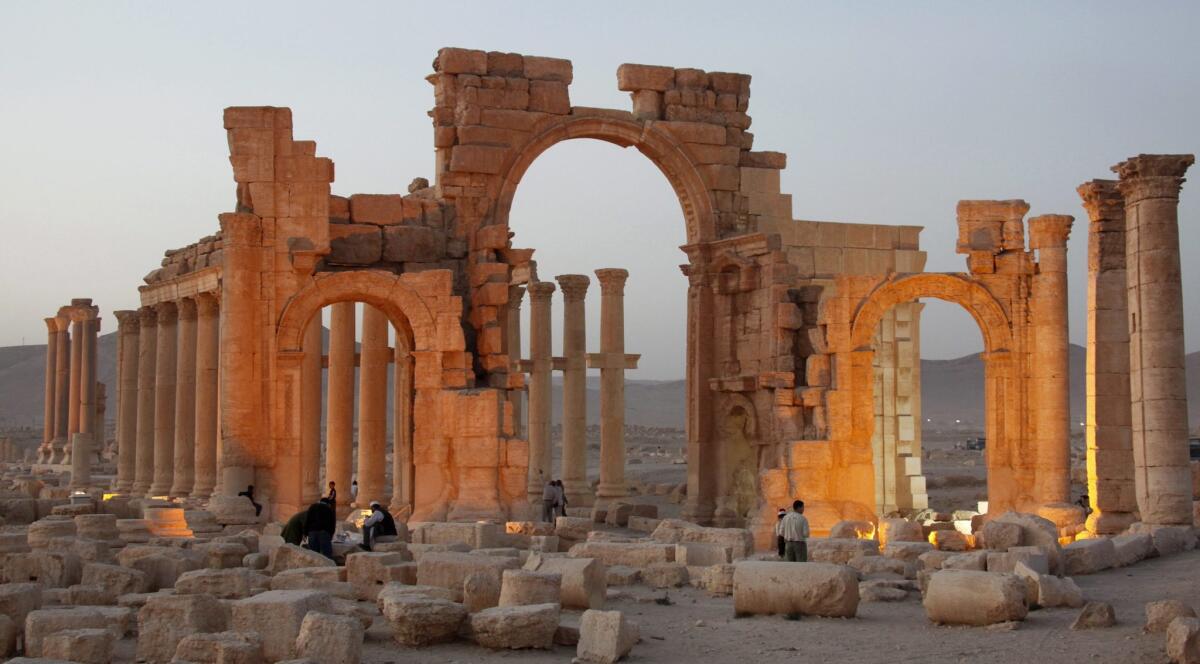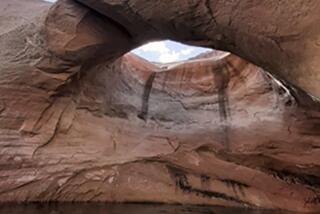Destruction of ancient arch another blow to historic site in Palmyra

Islamic State militants have blown up Palmyra’s ancient Arch of Triumph, pictured, according to Syrian activists.
- Share via
Reporting from BEIRUT — It was an iconic monument in Palmyra’s spectacular collection of artifacts, a triumphal arch from the third century that celebrated an emperor’s military victory.
Its obliteration on Sunday by Islamic State militants marks yet another blow to hopes that one of the world’s storied archaeological sites could avoid destruction.
“The arch was blown up yesterday, sources told us, but it seems they had planned to do this for some time,” said Maamoun Abdul Karim, Syria’s chief of antiquities, in a phone interview Monday from Damascus, the Syrian capital.
“Approximately four weeks ago, locals saw construction vehicles digging near the arch and that was when they mined it,” he said.
Much of the ancient oasis city has been mined, Abdul Karim added, possibly as a way to discourage any governmental offensive to retake the area.
In May, Islamic State forces overran Palmyra, 90 miles east of Homs, after a week-long siege ended with government troops collapsing before the onslaught. Its capture severely hampered Damascus’ reach to government-held parts of the country’s eastern desert.
A wave of summary executions marked its takeover. Islamic State staged a mass execution of suspected government collaborators in the majestic remains of an ancient Roman theater that had been the venue of an important music festival before the Syrian crisis erupted in 2011.
The militants also imposed their harsh brand of sharia, or Islamic law, raising the alarm that Palmyra’s landmarks would meet the same fate of other archaeological sites under its control. Islamic State views the artifacts as elements of pagan worship. In Mosul, Iraq, the group uploaded videos of militants using power drills and sledgehammers as they destroyed priceless historical pieces in the city’s museum.
In Palmyra, the militants initially smashed the 1,900-year-old statue of the lion god Al-Lat and a collection of graves and busts.
Soon, however, the extremists’ systematic erasure of Palmyra’s archaeological history took on greater scope.
Earlier in the summer, militants blew up the historic temples of Bel and Baalshamin. In August, Islamic State beheaded Khaled Asaad, the octogenarian scholar and retired director of Palmyra’s Museum. His mangled corpse was displayed on a main thoroughfare.
Yet even for Abdul Karim, the chief of antiquities, the destruction of the Monumental Arch represents a new phase of the Islamic State’s campaign against the city.
“The surprise was that they destroyed a building that was totally secular,” he said. ”To destroy a civilian building that is 1,800 years old … this is ignorance and hatred of civilization. Their goal seems to have been vengeance and nothing more.”
The destruction was ongoing, he stressed.
“We should be clear and transparent: We are losing every month or every two weeks another part of Tadmur construction and it is eternal,” he said, using the Arabic name for Palmyra.
The situation was so desperate, Abdul Karim continued, that every option should be explored to liberate the city – regardless of what effects it would have on the monuments.
“I’m not a politician or a military man, but we are before two choices: Do we sit and wait while Daesh stays in the area and they destroy building after building in the coming months, or do we go to liberate the city in a quick way to save what remains?” asked Abdul Karim, referring to the Islamic State by its Arabic acronym.
“Even if there is damage, surely the results will be better than letting those people stay in there. We welcome every intervention that will save Palmyra.”
Once the city was liberated, the Syrian antiquities chief said, the work could begin to restore Palmyra.
“We need to get closer to the area and see if everything has indeed been destroyed. If that’s the case we will have to rebuild with a copy,” he said.
“Even if it is a copy, we will do it, because every part of Palmyra is important.”
Bulos is a special correspondent. Times staff writer Patrick J. McDonnell in Beirut contributed to this report.
ALSO
Seoul: N. Korea releases detained South Korean student
High school shooting plot foiled in Northern California, authorities say
Doctor accused of looting ancient artifacts is indicted on 21 counts
More to Read
Sign up for Essential California
The most important California stories and recommendations in your inbox every morning.
You may occasionally receive promotional content from the Los Angeles Times.









